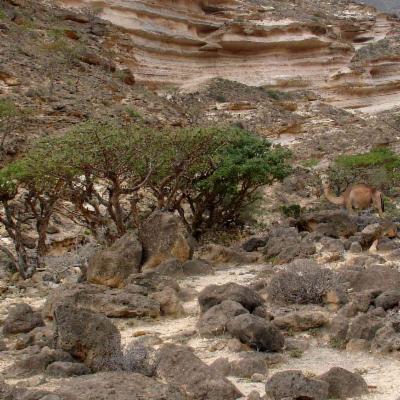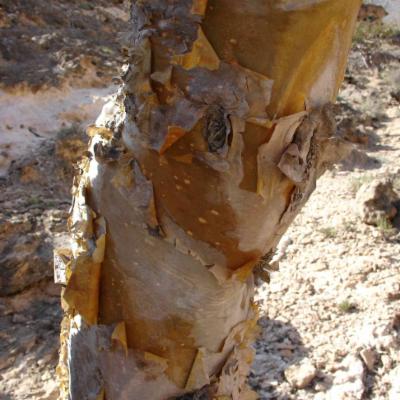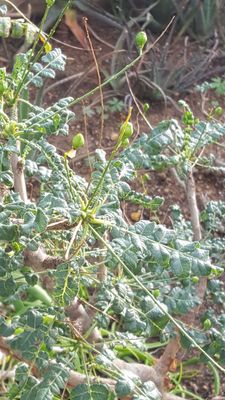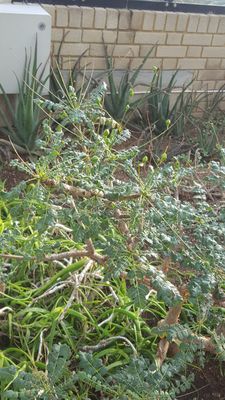Christmas and frankincense
Frankincense is strongly associated with Christmas, being named in the Bible as one of the three gifts brought to the baby Jesus by 'Three Wise Men' from the East, and has been used for thousands of years in many different cultures. The ancient Egyptians believed frankincense to be the sweat of gods, fallen to earth. The legendary Phoenix bird was believed to build its nest from twigs of frankincense and to feed upon 'tears' of the resin.
Geography and distribution
Native to Ethiopia, northern Somalia, south-western Oman and southern Yemen. It is most widespread in northern Somalia, and in the woodlands of the escarpment mountains of the southern coast of the Arabian Peninsula. These coastal mountains are blanketed in thick fog during the summer months, allowing the development of dense woodlands supporting a surprisingly rich flora: a 'fog oasis' in a desert region.
Description
Overview: Boswellia sacra is a tree growing up to 8 m tall with papery, peeling bark. Trees are normally multi-stemmed, but can also have a single trunk. All parts of the tree are highly resinous.
Leaves: The leaves are clustered at the tips of the branches and are divided into leaflets.
Flowers: The flowers are borne in axillary racemes up to 10 cm long, crowded together at the end of the branches. Each flower has five, spreading, yellow-white petals, ten stamens (male organs) and an ovary surrounded by a fleshy disc. The fruit is a 3-5 angled capsule of 8-12 mm, which opens by 3-5 valves.
The trees cling to boulders or rock-faces by means of a cushion-like swelling at the base of the trunk. This swollen base helps to stabilise the tree and is most developed in those growing on very steep or exposed rocks.
Threats and conservation
In Oman the tree is so heavily browsed by herbivores that it rarely flowers or sets seed, apparently leading to poor regeneration and the death of some trees.
Uses
Frankincense and olibanum are commonly used names for the oleo-gum-resin of Boswellia trees. Frankincense has long been valued for the sweet-smelling fumes it produces when burnt. The ancient Egyptians used the resin in religious rites, in anointing the mummified bodies of their kings, and to treat wounds and sores. Incense containing frankincense was found in Tutankhamen's tomb. It is still used in religious ceremonies by the Parsees, thought by some to be cultural descendants of the 'Three Wise Men' (Magi) of the Christian tradition.
The earliest recorded account of the use of Arabian frankincense and myrrh by the ancient Greeks comes from Herodotus, suggesting that by 500 BC a well-established trade existed between southern Arabia and Greece. In 295 BC Theophrastus recorded that Alexander the Greek (356-323 BC) sent Anaxicrates to southern Arabia to ascertain the origin of frankincense.
Theophrastus (c. 372-287 BC), the Greek botanist, and Pliny the Elder (23-79 AD), the Latin naturalist, provided eyewitness accounts of the cultivation and harvesting of frankincense, and the methods remain largely unchanged today. When slashed, the bark exudes an oily gum resin which is either scraped off the tree or collected from the ground as it drips off, a method which produces a better quality resin. The best quality resin is pale in colour, while resin which is scraped off the bark is reddish and considered inferior.
The frankincense tree begins to yield resin in its third or fourth year. Collectors make slight incisions or slashes in the stout lower branches with a special knife. The gum exudes at these points and hardens into a tear-shaped resinous substance. After about ten days the drops are large enough for collection. Frankincense is collected chiefly during the monsoon months, and in Oman (from where the best frankincense comes), is stored in mountain caves until the winter after the south-west monsoon is over. This delay enables the product to dry properly, though normally it can be ready for export ten to twenty days after collection. A single tree can yield several kilograms of resin each year.
Today, frankincense is used mainly in the manufacture of incense, and is regarded as an essential ingredient. Incense is used particularly in Roman Catholic and Greek Orthodox Churches, and also in the cosmetics and pharmaceutical industries, for perfumes, fumigating powders and pastilles. Burning incense is an effective insect repellent.
Frankincense has a wide range of traditional medicinal uses, for example in the treatment of digestive and respiratory complaints. Scientific research is underway into the possible use of Boswellia species in cancer treatment. The essential oil derived from frankincense contains a number of monoterpene hydrocarbons, such as pinene and limonene, and is used in aromatherapy. The fumes can have a stimulant effect. China is the main importer of the gum.
Frankincense at Kew
Boswellia sacra can be seen growing in the seasonally dry zone of the Princess of Wales Conservatory.
Pressed and dried specimens of B. sacra are held in the Herbarium, one of the behind-the-scenes areas of Kew. The details of some of these specimens, including images, can be seen online in the Herbarium Catalogue.
Samples of gum, resin and oil are also held in the Economic Botany Collection.











